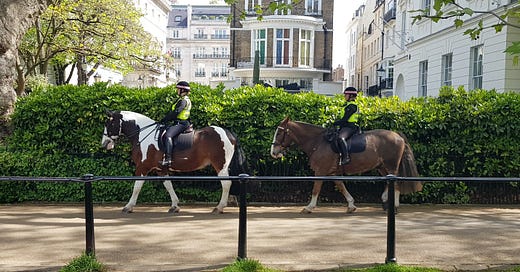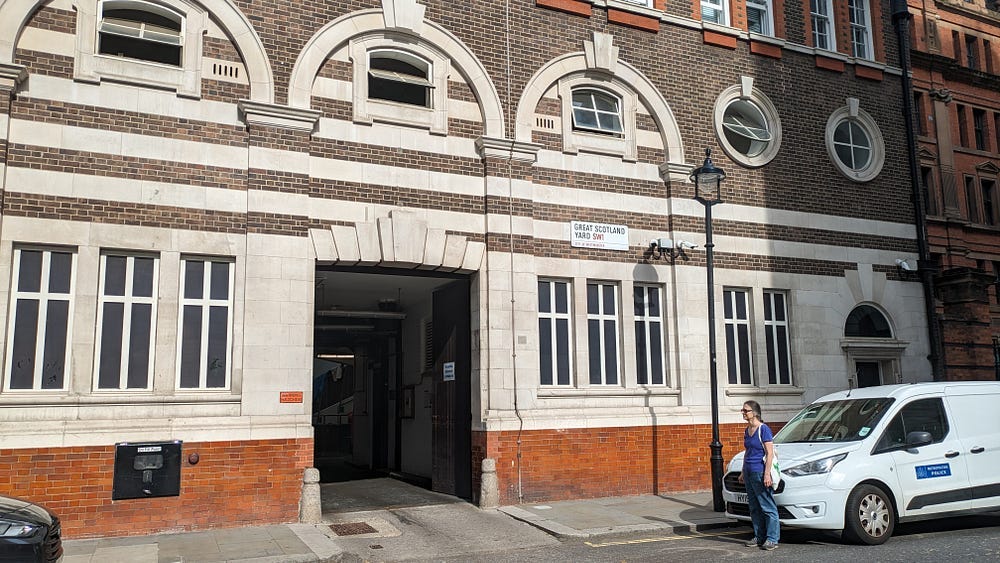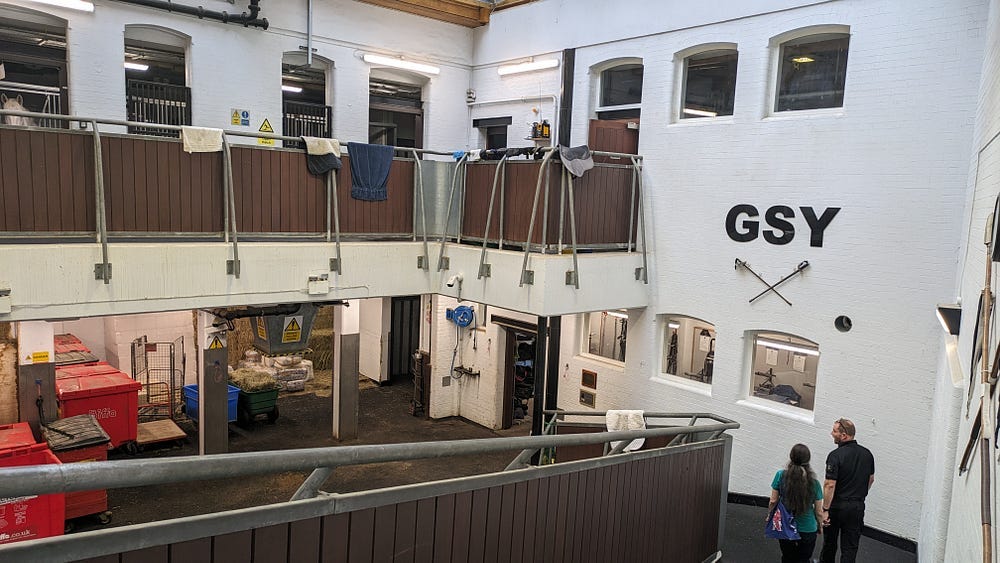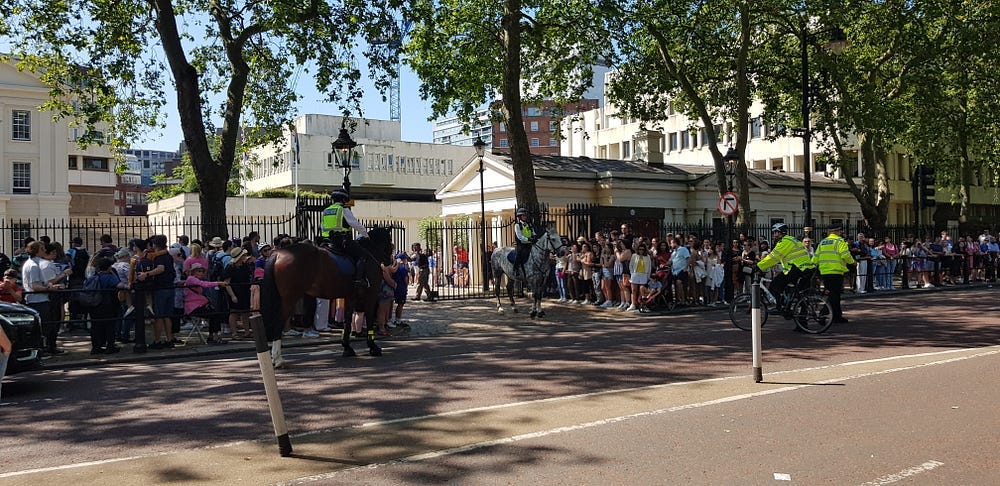Introduction
If you walk down to Great Scotland Yard — a street in central London in the Whitehall area — you could easily miss the stables. The entrance is so innocuous without any signage, you could mistake it for a delivery entrance.
Honestly, that’s what I thought it was, though I knew there were stables around there somewhere. It was only by walking down the passage to the railings barring entry that the unmistakable whiff of horses hit the nostrils.
There must surely be deliveries made there — deliveries of hay, and perhaps carrots, for the horses. I believe Police Horse Clyde used to live at these stables, and I read that his favourite food is carrots.
He’s now retired after 17 years of service, but his former companion Police Horse Trug still lives there. Here he is inside the stables with the police officer, who very kindly showed me around the stables impromptu as he had 10 minutes to spare before he went off duty.
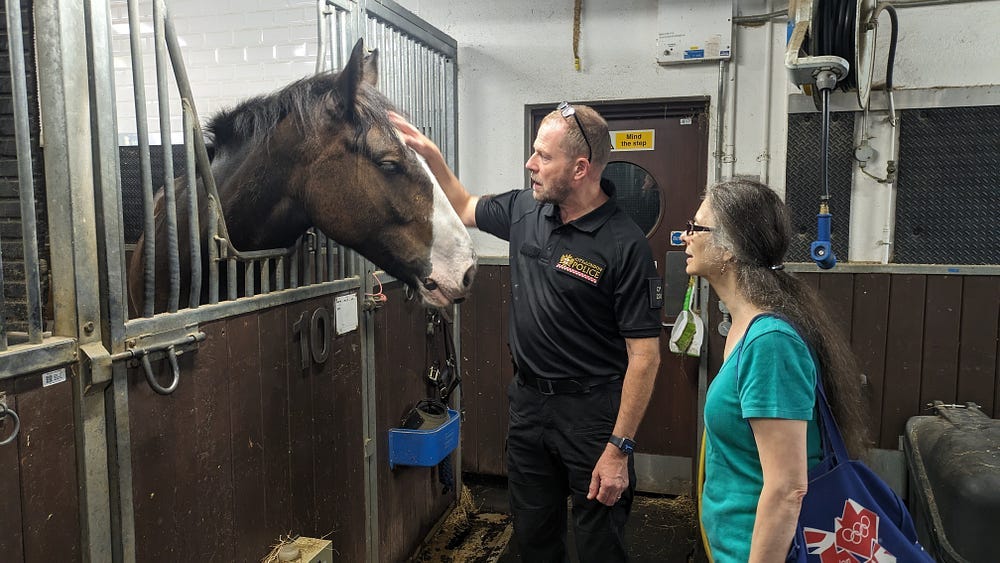
The stables
These stables are one of seven in London serving as home to the police horses. At Great Scotland Yard stables there are 19 stalls for the Metropolitan Police horses and two for the City of London police horses.
In case this is confusing you, let me explain that the City of London is an area of London colloquially known as the Square Mile for obvious reasons. It’s the financial and trading area of London, not the whole of London.
The City of London police horses came to stay at Great Scotland Yard stables temporarily in 2020. But the period has turned into three years, so the two stalls originally reserved for their horses are still very much in use!
The stables have two tiers. There’s a ramp for the horses to climb to the upper level. Below is a picture taken from the upper level showing the police officer and me walking down the ramp.
The GSY on the wall stands for Great Scotland Yard — the name of the stables. If you look carefully in the far left upper stall, you’ll just make out the white head and ears of a horse in his stall.
How Great Scotland Yard got its name
Before the Metropolitan Police owned them, these stables used to be the Royal Stables belonging to Whitehall Palace, once the largest palace complex in Europe.
In the 1500s and 1600s, Whitehall Palace was the main residence of the English monarchs, including King Henry VIII (the one with the six wives).
So where does the name Great Scotland Yard come from?
Yard is abbreviated from courtyard. A courtyard is an open area that is completely or partially enclosed by walls or buildings, and typical of a palace.
But Scotland?
Back in the 11th century, King Kenneth III of Scotland — whom you’ve probably never heard of — was given Whitehall Palace for his London residence.
Nice gift!
That’s where Scotland in Great Scotland Yard comes from. As for Great, probably because it was the grand residence of the monarch. You wouldn’t expect the royals to live anywhere lesser, now would you?!
In fact, there were three courtyards and one was the Great Courtyard, from which Great is derived, another qualified tour guide informed me.
The Mounted Police
You may not be familiar with Whitehall Palace. That’s because the palace itself burnt down in the 1690s.
They didn’t have sprinkler systems installed back then…
Only their stables survived. Now they are used by the Mounted Police.
Great Scotland Yard stables today belong to the Metropolitan Police of London. And they’ve had an upgrade. Now it’s the horses that get treated like royalty. These stables are air-conditioned no less!
Why did we need police on horses—the Mounted Police?
The highwaymen of London!
The Mounted Police were first introduced in 1760 to deal with the growing problem of these robbers on horseback, who would ambush a coach and horses and take all your money.
Their familiar demand was, “Stand and deliver!”
Another common threat by them was, “Your money or your life!”
Fortunately, we don’t have to worry about such criminals on horseback anymore.
Today the duties of the Mounted Police include:
high visibility patrols, especially in the royal parks
escorting the military and Royal Household in central London — a key role in counter-terrorism
crowd control at sporting events, demonstrations and ceremonial occasions such as Trooping the Colour and Changing of the Guard
Below is a picture of the Mounted Police assisting with crowd control at the gates of Wellington Barracks for the Changing of the Guard. One horse is brown, the other a dappled grey. You can see the police wear high-viz jackets, including the one on the bicycle and the one on foot next to him on the right.
The next picture shows Mounted Police from both the Metropolitan Branch with their black and white checks on the helmets and the City of London branch with their red and white checks on their helmets.
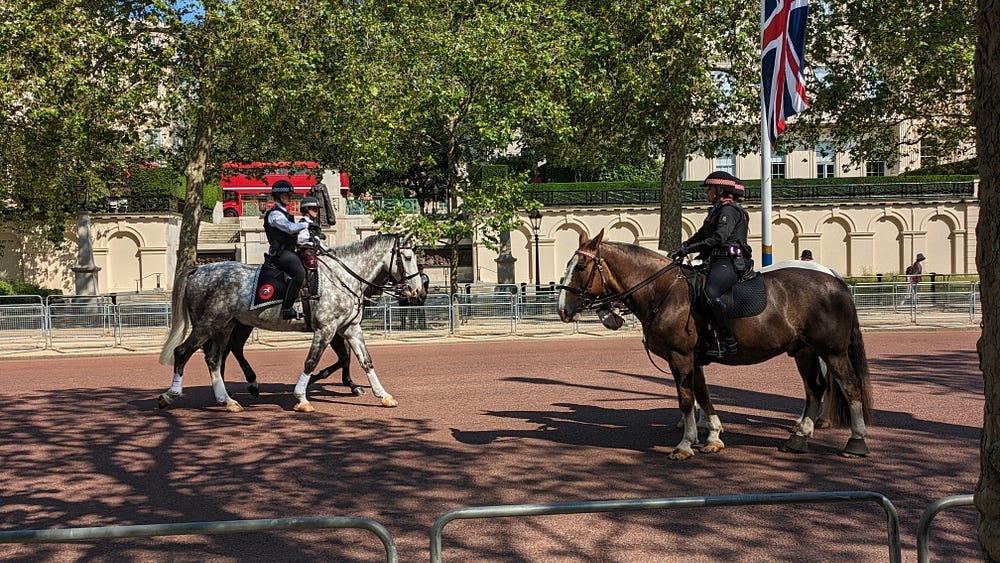
Another important role for the Metropolitan Police is positive community engagement with the public.
Apparently, members of the public prefer to talk to a police officer on a horse than a police officer on foot. There’s something about an animal that bridges the gap between authority figures and us, isn’t there?
Finally…
To end, here is a fun picture from my collection of the Mounted Police all lined up having a photo shoot in advance of the rehearsals for the Trooping the Colour (the official King’s birthday celebration). It’s a rare sight to have so many Mounted Police together.

Alternatively, you might like to help keep the inspiration flowing with a little tip to:
